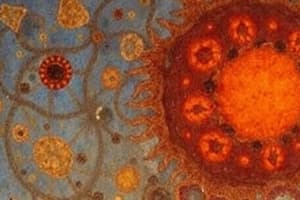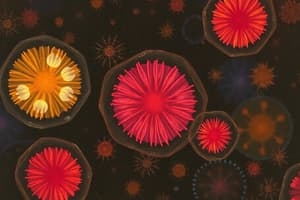Podcast
Questions and Answers
What is the primary function of translation in cells?
What is the primary function of translation in cells?
- To produce RNA
- To synthesize proteins (correct)
- To degrade waste materials
- To replicate DNA
Which term describes the variety of life on Earth?
Which term describes the variety of life on Earth?
- Biodiversity (correct)
- Biome
- Ecosystem
- Population
What is a key mechanism of evolution that enhances survival and reproduction?
What is a key mechanism of evolution that enhances survival and reproduction?
- Genetic drift
- Horizontal gene transfer
- Natural selection (correct)
- Artificial selection
What kind of reproduction results in genetically identical offspring?
What kind of reproduction results in genetically identical offspring?
Which system is NOT typically involved in maintaining homeostasis in the human body?
Which system is NOT typically involved in maintaining homeostasis in the human body?
What process results in the formation of gametes?
What process results in the formation of gametes?
How are organisms classified in biological taxonomy?
How are organisms classified in biological taxonomy?
Which of the following best defines an ecosystem?
Which of the following best defines an ecosystem?
What is the primary function of ribosomes in a cell?
What is the primary function of ribosomes in a cell?
Which organelle is responsible for performing photosynthesis in plant cells?
Which organelle is responsible for performing photosynthesis in plant cells?
What is a major difference between prokaryotic and eukaryotic cells?
What is a major difference between prokaryotic and eukaryotic cells?
What process occurs in the mitochondria to generate ATP?
What process occurs in the mitochondria to generate ATP?
In which part of the chloroplast do the light-dependent reactions of photosynthesis take place?
In which part of the chloroplast do the light-dependent reactions of photosynthesis take place?
What is the primary role of lysosomes within a cell?
What is the primary role of lysosomes within a cell?
What is the function of the Golgi apparatus in a cell?
What is the function of the Golgi apparatus in a cell?
Which of the following statements about DNA is true?
Which of the following statements about DNA is true?
Flashcards
Cells
Cells
The fundamental units of life, having a complex internal structure and specialized organelles.
Prokaryotic cells
Prokaryotic cells
Cells lacking a nucleus and membrane-bound organelles. Examples include bacteria and archaea.
Eukaryotic cells
Eukaryotic cells
Cells with a nucleus and membrane-bound organelles. Examples include plants, animals, fungi, and protists.
Cellular respiration
Cellular respiration
Signup and view all the flashcards
Glycolysis
Glycolysis
Signup and view all the flashcards
Photosynthesis
Photosynthesis
Signup and view all the flashcards
Genes
Genes
Signup and view all the flashcards
Heredity
Heredity
Signup and view all the flashcards
Ecology
Ecology
Signup and view all the flashcards
Ecosystem
Ecosystem
Signup and view all the flashcards
Population
Population
Signup and view all the flashcards
Community
Community
Signup and view all the flashcards
Biodiversity
Biodiversity
Signup and view all the flashcards
Evolution
Evolution
Signup and view all the flashcards
Adaptations
Adaptations
Signup and view all the flashcards
Speciation
Speciation
Signup and view all the flashcards
Study Notes
Cell Structure and Function
- Cells are the fundamental units of life, possessing a complex internal structure and specialized organelles.
- Prokaryotic cells (bacteria and archaea) lack a nucleus and membrane-bound organelles.
- Eukaryotic cells (plants, animals, fungi, and protists) have a nucleus and membrane-bound organelles.
- The cell membrane regulates the passage of substances in and out of the cell.
- The cytoplasm is the gel-like substance within the cell that surrounds the organelles.
- The nucleus contains the cell's genetic material (DNA).
- Mitochondria are the sites of cellular respiration, generating energy.
- Ribosomes synthesize proteins.
- Endoplasmic reticulum (rough and smooth) plays a role in protein synthesis and lipid metabolism.
- Golgi apparatus modifies, sorts, and packages proteins.
- Lysosomes contain digestive enzymes for waste breakdown.
- Vacuoles store water and nutrients in plant cells.
- Chloroplasts perform photosynthesis in plant cells.
Biological Molecules
- Carbohydrates are composed of carbon, hydrogen, and oxygen, providing energy. Examples include sugars and starches.
- Lipids are diverse molecules that include fats, oils, and steroids, important for energy storage and membrane structure.
- Proteins are polymers of amino acids playing numerous roles in structure, function, and regulation.
- Nucleic acids, DNA and RNA, store and transmit genetic information.
Cellular Respiration
- Cellular respiration is the process by which cells break down glucose to release energy in the form of ATP.
- Glycolysis is the initial step, breaking down glucose into pyruvate.
- The Krebs cycle occurs in the mitochondrial matrix, releasing carbon dioxide and generating electron carriers.
- The electron transport chain uses electron carriers to produce ATP.
Photosynthesis
- Photosynthesis is the process by which plants convert light energy into chemical energy in the form of glucose.
- It occurs in chloroplasts, specifically in the thylakoid membranes.
- Light-dependent reactions capture light energy and produce ATP and NADPH.
- Light-independent reactions (Calvin cycle) use ATP and NADPH to fix carbon dioxide into glucose.
Genetics
- Heredity is the transmission of traits from parents to offspring.
- Genes are segments of DNA that code for specific traits.
- Chromosomes are structures that carry genes.
- DNA replication ensures genetic material is copied accurately.
- Transcription creates RNA from DNA.
- Translation synthesizes proteins using the information in RNA.
- Mutations are changes in DNA sequence and can lead to variations.
Ecology
- Ecology is the study of the interactions between organisms and their environment.
- Ecosystems encompass all living and non-living components in a specific area.
- Populations are groups of individuals of the same species in an area.
- Communities are multiple populations interacting in an area.
- Biodiversity refers to the variety of life on Earth.
- Food chains and food webs depict energy flow between organisms.
- Biomes are large-scale regions with characteristic climate and life forms.
- Cycles like the water cycle, carbon cycle, and nitrogen cycle are essential for ecosystem functionality.
Evolution
- Evolution is the change in heritable characteristics of biological populations over successive generations.
- Natural selection is a key mechanism of evolution, favoring traits that enhance survival and reproduction.
- Adaptations are traits that enhance survival and reproduction in a specific environment.
- Speciation is the process by which new species arise.
- Common ancestry connects all life forms through evolutionary relationships.
Reproduction
- Asexual reproduction produces offspring genetically identical to the parent.
- Sexual reproduction involves the fusion of gametes (sperm and egg) creating a genetically unique offspring.
- Types of asexual reproduction include budding, binary fission, and fragmentation.
- Meiosis is the process that produces gametes.
Classification
- Organisms are classified into hierarchical categories (e.g., domain, kingdom, phylum, class, order, family, genus, species).
- Classification systems reflect evolutionary relationships.
- Binomial nomenclature is the two-part naming system for species using genus and species names.
Human Biology
- Human biology studies the structure and function of the human body and how it works.
- Systems like the circulatory, respiratory, nervous, digestive, and endocrine systems work together.
- The integumentary system protects the body from harm.
Studying That Suits You
Use AI to generate personalized quizzes and flashcards to suit your learning preferences.




